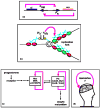Making cellular memories
- PMID: 20085698
- PMCID: PMC2882105
- DOI: 10.1016/j.cell.2009.12.034
Making cellular memories
Abstract
The induction of a protracted response to a brief stimulus is a form of cellular memory. Here we describe the role of transcriptional regulation in both natural and synthetic memory networks and discuss the potential applications of engineered memory networks in medicine and industrial biotechnology.
Figures



References
-
- Alon U. An introduction to systems biology: Design principles of biological circuits. Chapman & Hall/CRC Press; Boca Raton, FL: 2006.
-
- Atkinson MR, Savageau MA, Myers JT, Ninfa AJ. Development of genetic circuitry exhibiting toggle switch or oscillatory behavior in Escherichia coli. Cell. 2003;113:597–607. - PubMed
Publication types
MeSH terms
Grants and funding
LinkOut - more resources
Full Text Sources
Other Literature Sources

